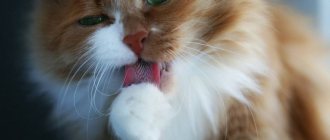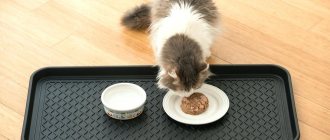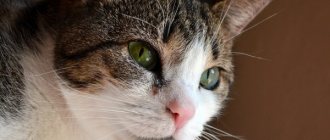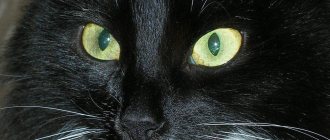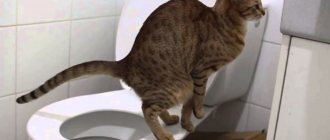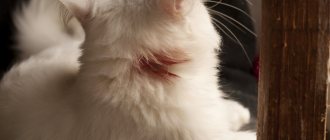Causes
Pus from the nose
Diseases in which pus is discharged from the nose are divided into contagious and non-contagious.
The following are considered contagious:
- Herpes (rinotracheitis);
- Calicivirus;
- Cat flu;
Among the diseases of non-contagious etiology, the following most often develop:
- chronic diseases and colds;
- foreign bodies;
- congenital anomalies;
- tumors.
The causes of diseases, clinical symptoms, methods of diagnosis, treatment and prevention are not the same. Let's consider each disease separately.
Herpes (rhinotracheitis)
Herpes
The disease occurs among unvaccinated cats when kept in crowded conditions, unbalanced feeding in nurseries or shelters. Sick kittens die 10-14 days after the first signs appear. Those who have recovered become a reservoir of infection. There is a high probability of transplacental infection. The owner brings the virus into the apartment.
In addition to nasal discharge and cough, stomatitis, conjunctivitis with subsequent ulceration of the cornea, and mouth breathing develop. Constipation occurs and pregnant women abort. In the chronic course of the disease, panophthalmitis develops and the cat goes blind. An accurate diagnosis is established in the clinic.
The treatment is developed by a veterinarian. Prevention consists of timely vaccination, bringing living conditions and feeding into compliance with standards. If a cat refuses to eat for a long time, it is fed through a nasoesophageal tube. If signs of dehydration are detected, droppers with plasma substitutes are placed.
Nasoesophageal tube
When the cat begins to feed on its own, the veterinarian prescribes wet canned food or soaked granules.
Be sure to read:
A kitten's eyes are festering: normal or pathological, reasons, what to do at home, medications
Calicivirus
Ulcerative glossitis with calcivirosis.
In terms of symptoms, etiology, and pathogenesis, the viral disease resembles Herpes. A cough occurs and bronchopneumonia develops.
Distinctive features are ulcerative stomatitis and the absence of ulcerations on the cornea. Lameness appears suddenly, but disappears spontaneously after a few days. The treatment strategy and prevention are the same as for Herpes.
Cat flu
Polyvalent vaccine
Often Herpes and Calicivirus affect a pet at the same time. The disease was called cat flu. When making a diagnosis, attention is paid to the presence of signs of both diseases. A complex vaccine against calicivirus, rhinotracheitis and panleukopenia reliably protects against infection.
Cat flu is not dangerous to humans.
How to help your pet
It is better not to treat an animal with “water” from the nose yourself, but to show it to a veterinarian. It is he who will remove the foreign body that contributes to the discharge or establish the type of disease (it can be parasitic, allergic, viral or bacterial).
© shutterstock
A runny nose for a cat (water from the nose) can be a consequence of injury, for example:
- Damage to the skull;
- Neoplasms;
- Pathological disease of the upper jaw.
Most often, the intervention of a veterinary surgeon is required. It is impossible to cure a cat on your own.
When treating a runny nose, the pet's nose is washed. This must be done carefully, preferably with an insulin syringe without a needle. Then lubricate the nose and the crusts that have formed on it with ointment so that they soften. Dead particles are removed.
After the nose is washed, drops are placed in the animal's nose or lubricated with ointment. The ointment is prescribed depending on the disease; it can be antiviral or antiparasitic.
If water is flowing from your cat’s nose, you can use folk remedies:
- Place beet juice in your nose (not concentrated);
- Add streptocide powder;
- Drip ecmonovocillin (dilute with half of the saline solution before use);
- Instill halozolin, diluted twice.
To increase the animal’s immunity, you need to instill thymogen for 10 days without a break. Place one or two drops in each nostril.
If your pet has a runny nose and the runny nose is determined to be parasitic, then treatment should be prescribed by a doctor. The owner himself can determine why the nose is running: clear and profuse snot, changing the smell to a more unpleasant one . These signs indicate a parasitic type of runny nose.
© shutterstock
The veterinarian can prescribe antibiotics to the animal, regardless of the type of disease. You cannot treat an animal with human medicines - there are special means for them.
Chronic diseases and colds
Rhinitis occurs as a symptom of exacerbation of the following permanent diseases:
- diabetes;
- urolithiasis disease;
- renal pathologies.
Too frequent bathing leads to hypothermia and reflex swelling of the mucous membrane. Ventilating rooms freshens the air, however, cats cannot tolerate drafts and become hypothermic. In hot weather, you should not leave your pet in a room with air conditioning running, otherwise he will catch a cold.
If the disease is caused by hypothermia, and the pet’s health is satisfactory, use dual-use drops - Maxidin or Anandin. Drugs intended for humans should not be used without the approval of a veterinarian.
Symptoms for which you should visit a doctor
Feline rhinitis requires timely and adequate treatment. It is better to visit a veterinarian as soon as possible if your pet has the following pathological signs:
The animal needs to be taken to the doctor if it also develops a cough.
- profuse clear, yellow, green or purulent nasal discharge that does not stop for a long time;
- lethargy, apathy, depression, constant drowsiness;
- refusal to eat and drink;
- increased body temperature;
- constant itching, which is relieved by rubbing the animal’s nose with its paw;
- inflammation of the conjunctiva, cough, sneezing.
Congenital anomalies
Spontaneous selection leads to the birth of offspring predisposed to rhinitis. Sometimes kittens are born with a deviated nasal septum.
Hypothermia or a reaction to odors leads to reflex swelling of the mucous membrane and rhinitis. Atopic dermatitis occurs in predisposed cats over one year of age. This is a reaction to dust, smoke and odors. Along with a runny nose, cats develop cough, conjunctivitis, and skin diseases.
Be sure to read:
The cat eats poorly and loses weight: causes, safe and dangerous symptoms, first aid, treatment
Congenital anomalies are incurable. However, with a successfully developed therapeutic strategy, exacerbations can be stopped.
Why do cats have runny noses?
Nasal discharge in a cat is the body’s response to exposure to a virus or bacteria . The secreted mucus has bactericidal and antiviral properties. In fact, by secreting mucus, the animal’s body tries to cope with the infection itself. It cleanses the cat's nasopharynx, provides it with protection from drying out, and removes irritation. Everything unnecessary is pushed out. Depending on the source of the disease, nasal discharge may have different consistency, intensity and color. Discharges can be:
- Transparent, liquid, viscous and viscous, cloudy.
- White with a yellowish tint, gray-green.
- Abundant and periodic.
- They can only flow at certain times.
- They can cause sneezing and wheezing or flow freely.
Before contacting a veterinarian, the cat owner should remember all the symptoms he sees. In the future, this knowledge will help the specialist make a more accurate diagnosis. It is recommended to remember all the nuances: whether the cat rubs its nose with its paw, how soundly it sleeps, how it eats, whether its mouth is open during sleep, etc.
Most importantly, you should not try to treat your animal yourself. Yes, you may be able to cope with a runny nose, but without knowing its cause, you will not get rid of the disease . Therefore, in any case, you need to seek help from a veterinarian.
Prevention
To maintain the health of your pet, preventive measures should not be neglected:
- avoid drafts and prevent the animal from overcooling;
- ensure that the cat’s diet is balanced with a sufficient amount of essential vitamins and microelements, and the animal must also have constant access to clean drinking water;
- limit contact with wild or stray animals and birds;
- avoid contact of the cat with possible allergens;
- prevent the appearance of parasites (fleas, worms);
- Vaccinate your animal annually to help reduce the risk of disease.
Even if the pet does not go outside, there is always a risk that the virus entered the house on the owner’s shoes or clothes. This is another reason to wash your hands more often and keep your home clean.
Paying close attention to your pet will help you notice changes in behavior and physical health in a timely manner. After all, the sooner you start treatment, the faster the result will be.
Treatment of rhinitis caused by fungi, parasites and allergens
The fungal flora that most often provokes rhinitis is called cryptococcal. To eliminate it, Itraconazole, Fluconazole and other similar drugs are prescribed. The amount of medication depends on the weight of the cat, and the course of treatment is long and lasts at least a month. The first drug is prescribed at a dose of 5 mg per kg once a day. The second medicine must be given to the pet twice a day, 50 mg. The required amount must be dissolved in 1 tsp. boiled water and pour into the animal’s mouth on an empty stomach.
During therapy with antifungal drugs, a cat's appetite may worsen, digestive problems may occur, as well as nausea and vomiting. If such symptoms appear, you should notify your doctor to adjust the dosage.
Fluconazole is active against fungal flora
To eliminate a runny nose caused by parasites, special drops are used on the withers, which can get rid of helminths, as well as fleas, ticks and lice-eaters. Such products should be used once. After 24 hours, all parasites will leave the pet’s body. Drops are applied to the skin, spreading the fur in the withers area. Most often, Dironet, Prazicide, Bars and others are used for treatment. Drops applied to the skin are generally well tolerated. Only occasionally may the pet feel worse and become lethargic.
Dironet gets rid of parasites
If a symptom occurs against the background of an allergy, then it is important to identify the provoking factor and eliminate it. Antihistamines are also used additionally for treatment: Suprastin, Zodak, Tavegil, etc. It should be remembered that these medications do not eliminate allergies, but only relieve symptoms. It is enough to give the animal a quarter of a tablet per day on an empty stomach. The course of treatment should not exceed 7 days. When treated with antihistamines, the pet may appear lethargic, which is caused by a slight sedative effect. After discontinuation of the drugs, the animal’s condition returns to normal.
Tavegil relieves allergy symptoms
It is recommended to provide your pet with rest during treatment. It is important to protect your cat from stress, monitor its diet and prevent hypothermia.
How to rid a cat of a runny nose - video
This is interesting: What to do if a cat has a swollen nipple?
What to do if your cat's nose is festering
As a rule, a complex treatment of the cat is carried out, aimed at normalizing the respiratory function and general condition of the animal.
The following is used in treatment:
- antibacterial, antiparasitic agents in injections, tablets, drops;
- antifungal drugs;
- immunomodulators;
- homeopathy remedies;
- physiotherapeutic procedures;
- alternative medicine.
What are the consequences of a cold in cats?
Like other warm-blooded animals, a cold in cats can lead to serious consequences. A seemingly mild illness can provoke the development of pneumonia, cause rheumatoid joint damage, and lead to kidney disease.
If a cat has a runny nose and sneezes, then this means one thing - the animal’s immunity is reduced . His body is not able to cope with serious infectious diseases. Any contact with a pathogenic microbe or virus is likely to cause serious health problems and lead to the development of severe pathology. Therefore, it is very important to start treating your pet at the first sign of a cold.

